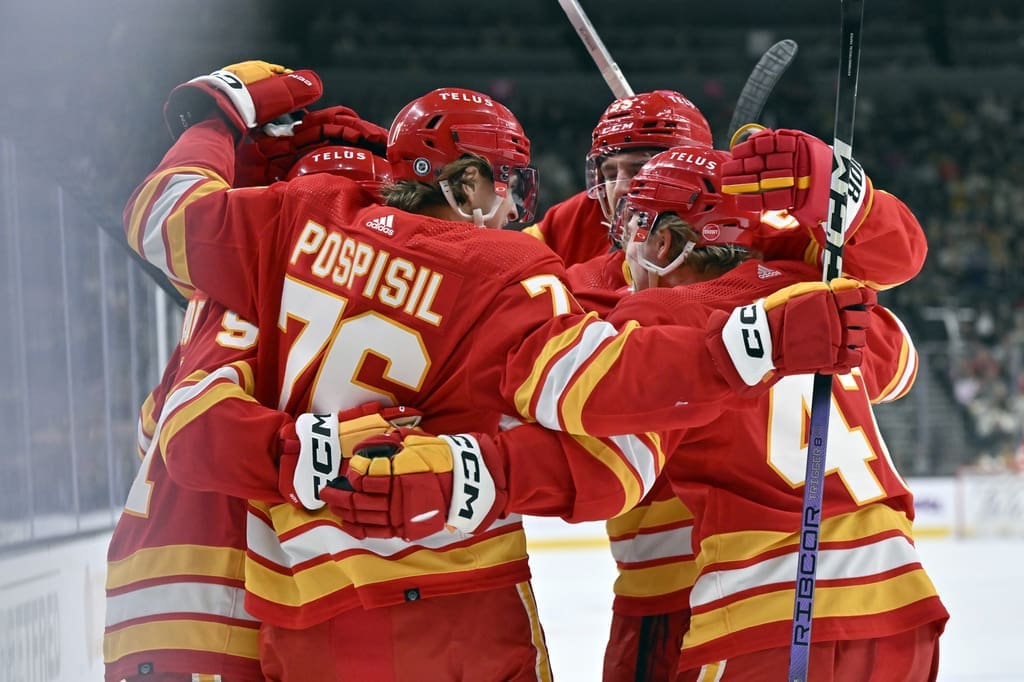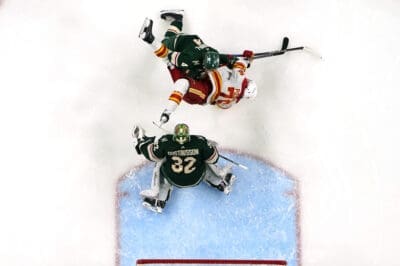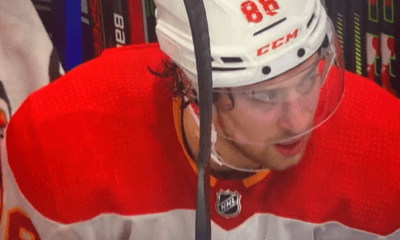Calgary Flames
Stats Flips: Which Flames Players Were the Fastest Skaters in 2023-2024

If you weren’t tuning in this season, you could make a case that the Calgary Flames didn’t move the needle much in terms of on-ice results.
A lower finish in the standings – 16th last season vs 23rd this season.
More goals against. 267 this year vs 247 with Darryl Sutter coaching in 2022-2023.
Less goals for. 253 this year. Surprisingly, Sutter’s slow-boiled five-man zone exits, and entries slightly edged that mark with 258 in his final year as head coach of the Flames.
The obvious explanation is the talent exodus. Losing offensive threats such as Tyler Toffoli, Noah Hanifin, and Nikita Zadorov (14 non-power play goals in 2022-2023) certainly affects end-of-season team goal totals.
Likewise, on the defensive end of the game, Chris Tanev and Noah Hanifin received the brunt of the heavy-lifting defensive assignments this season before the two were shipped off to Dallas and Vegas, respectively, before the deadline.
Interestingly enough, the Flames had the same amount of points (67) with the same number of games played (62) at the trade deadline in each of their past two seasons. Moving out Tanev and Hanifin served as the primary difference-maker (on paper) between the two campaigns.
The Flames limped to an 8-13-0 finish without their go-to stalwart pairing. Over that stretch-drive span, the team was outscored 62-80 and found themselves drifting into the draft lottery conversation. The Flames ended up finishing in 24th place and will enter the 2024 draft lottery with a 5% chance of moving up to first overall.
On paper, 2023-2024 was a very similar season to 2022-2023.
Tuning in, you may as well have given the team a new name and a fresh jersey concept. Ryan Huska had the group reformat their entire style of play.
Huska Hockey
Out went the Sutter-style man coverage in exchange for zone defence or box plus one. Returning members of the team had to drop their previously conditioned on-ice habits and start from near scratch when it came to defending and moving the puck up the ice.
Far less five-man units puttering over the offensive blue line and far more risk-taking transitional play in terms of zone exits.
Stephen Shea and Christopher Baker conducted a study using a 60-game sample size during the 2016-17 season on success rates based on transition vs. non-transition offensive opportunities. A transition opportunity is defined as any attack where the offence outnumbered the defence. Anything between a 1-on-0 to a 3-on-2 was included. A quick glance at the results was that a non-transitional opportunity (set up in the zone and generate shots) yielded a 1.8% chance of resulting in a goal. Transition opportunities led to a goal 18% of the time. For more analysis on the value of transition hockey, take a look at the book the two published in 2017.
Context varies greatly in hockey, but it’s encouraging to see that Craig Conroy and Ryan Huska are implementing a more exciting on-ice product and have already proven that, given the right personnel, they can do just as well as Darryl Sutter’s tooth-pulling 2022-2023 approach.
The question is, what kind of players are the right personnel for Ryan Huska’s counterpunch-style offensive approach?
Fitting a Transition System
Three factors translate well into a transition system: speed, above-average hockey IQ, and creativity. Several Flames players brought one or more of those factors during bounce-back or career seasons in 2023-2024.
Nazem Kadri put up his second-best season in terms of offensive totals with 29 goals and 46 assists for 75 points in 82 games. While his speed isn’t his calling card, his relentless approach to generating transition hockey was served well once his game got going in early November.
Stuck to Kadri’s hip was rookie Martin Pospisil, who, on many nights, exhibited exceptional hardline acceleration when crossing the blue lines.
We may not have seen the 24-year-old Slovak’s contribution impact the scoresheet as much as one would expect, given his sheer noticeability during games. 24 points in 63 games while serving in a top-six role is markedly below average, but defenders dealing with the combined threat of losing a step to his speed, as well as the potential of receiving a punishing Pospisil bodycheck, created plenty of time and space for Kadri and either Connor Zary or Andrei Kuzmenko to get creative when moving the puck up the ice.
Even Strength Goal Differentials
Zary-Kadri-Pospisil
TOI: 381:24
Goals For: 19
Goals Against: 10
GF%: 65.5%
Kuzmenko-Kadri-Pospisil
TOI: 134:42
Goals For: 10
Goals Against: 6
GF%: 65.5%
As rough as a stat as it is, the rest of the Flames forward lines barely kept their heads above water at 5v5.
Per MoneyPuck, Mangiapane-Lindholm-Huberdeau outscored the opposition 6-4 (60%), Mangiapane-Backlund-Coleman 23-22 (51.1%) and Greer-Ruzicka-Dube 3-3 (50%) were the only forward lines to play +80 minutes and maintain a positive even strength goal differential.
It should come as no surprise that two lines, both featuring the fastest skater on the Flames, also happened to produce the best results within Huska’s counterpunch offensive system.
We’ve pointed out that Poispisil is fast. Surely, the eye test supports that notion, but let’s use NHL Edge’s data to see which forwards stand out as either fast or, well, not fast on the Flames. Some of the results are quite surprising.
Total Speed Bursts Over 20mph
Martin Pospisil: 153
Mikael Backlund: 120
Andrew Mangiapane: 105
Blake Coleman: 80
Nazem Kadri: 78
Yegor Sharangovich: 73
League Average: 73
Kevin Rooney: 70
Jonathan Huberdeau: 44
AJ Greer: 40
Matthew Coronato: 39
Connor Zary: 29
Dryden Hunt: 14
Jakob Pelletier: 9
Andrei Kuzmenko: 6
Adam Klapka: 6
Cole Schwindt: 3
First observation: Kuzmenko is a surprise. For a player who appears to be moving at blurred framerates, he didn’t hit 22mph or higher at all through 72 games. Likewise, for all the times Yegor Sharangovich broke to the outside this season, he rarely clocked in at over 20 miles per hour. He hit above 22 miles per hour only four times in 2023-2024; the league average is four times.
Before we apply these numbers to a per 60 rate, we can gather two things from this raw data alone. Martin Pospisil is very fast, and his linemates don’t need to be fast to benefit from what he provides by bringing the puck over the lines with such speed or by cutting a second or two of time out of an opposing breakout.
Speed Bursts over 20mph Per 60 Minutes of Ice Time
Martin Pospisil: 11.46
Kevin Rooney: 11.36
Walker Duehr: 10.90
Adam Klapka: 9.09
Cole Schwindt: 6.66
Matthew Coronato: 5.46
Andrew Mangiapane: 5.62
AJ Greer: 4.60
Mikael Backlund: 4.56
Jakob Pelletier: 4.50
Blake Coleman: 3.59
Nazem Kadri: 3.09
Yegor Sharangovich: 3.08
Dryden Hunt: 2.68
Jonathan Huberdeau: 1.87
Connor Zary: 1.80
Andrei Kuzmenko: 0.33
Now that is some fun data. You’ll notice the more prominent playmakers on the team sitting right at the bottom. That may be a combination of playmakers tending to wait until they draw a defender and provide themselves with more passing targets, and it may be a matter of simply having a burner on their line to do the heavy lifting in the neutral zone.
That may explain part of it, but Andrei Kuzmenko is a surprise. The definition of a quick-in-tight player, his top-end speed may serve as a bit of reasoning as to why he was overlooked by so many scouting groups prior to breaking out in the KHL. The 28-year-old signed as a free agent with the Canucks during the summer of 2022.
You may also notice that the players sitting at the top of that list aren’t necessarily the most heavily deployed. The top six are all forwards averaging 12:43 or less of ice time per game. It’s safe to apply common sense there and assume that the more rested player can expend more energy during their limited opportunities on the ice.
Two extreme positives. Obviously, Martin Pospisil’s reign of both quality and quantity when it comes to speed is the big one. The other is Kevin Rooney, who committed hard to improving his skating as he dealt with a series of upper body injuries.
What Now?
Naturally, you would expect Craig Conroy to pursue more high-speed threats this offseason. The team’s 24th place finish may be explained by the fact that the roster needs one or two more players that can fill an empty lane and convert a turnover into a transition opportunity.
More from CHN:
[Five Mind-Blowing Stats as Flames Become the Nate Diaz of the NHL]

(AP Photo/Abbie Parr)
For more Flames news, visit Calgary Hockey Now and like our Facebook page.
Follow us on 𝕏:








